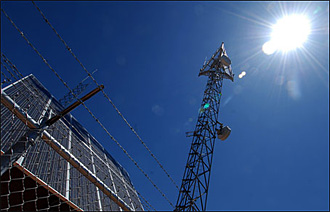
|  |  |  Technology News | July 2009 Technology News | July 2009  
US Virtual Fence Gets a 'Do Over'
 William Booth & Travis Fox - Washington Post William Booth & Travis Fox - Washington Post
go to original


| | A newly constructed tower in the "virtual fence." |  |
Sasabe, Arizona - After years of frustration, controversy and delay - and some maddening technological glitches - the first link in the federal government’s new $6.7 billion “virtual fence” is being erected here along the border.

We visited a newly constructed detection tower, out in the middle of Buenos Aires National Wildlife Refuge. Contractors were still plugging in the off-the-shelf components. The concept is simple. The execution is not. A previous test of the virtual fence concept was so plagued with snafus that the Department of Homeland Security scrapped it and announced a “do over.”

“We created a set of expectations that were unreasonable, and unfortunately it didn’t work as well as we would have liked,” says Mark Borkowsky, director of the project in the Customs and Border Protection agency.

According to Borkowsk, this is the basic idea: In a 23-mile-long section of Arizona desert, the agency and its contractor, the Boeing Company, will erect a picket line of 17 towers - nine towers will hold the detectors, eight will handle communications.

Atop each 80-foot-tall detection tower are a radar and two cameras - one camera works with daylight and another detects heat signals at night. A nearby communications tower will send data back to a command center in Tucson.

Each radar will sweep back and forth 24/7, looking for movement in its viewshed. Borkowsky explains the radars are calibrated to detect over a distance of several miles an animated object 4 feet or taller moving at a walking pace or faster. When the radar pings on something intriguing, the cameras will zoom in to answer, Borkowsky hopes, the following questions: “Are you a cow, a car or a person? Are you on horse or on foot? Is it a group of persons? Are you carrying a backpack or are you carrying a weapon?”

What the cameras see will be viewed on a computer screen back in Tucson where an agent will analyze the image. If the agent at the computer concludes the cameras have identified a group of illegal migrants (versus a troop of Boy Scouts or a cowboy chasing cattle) a Border Patrol agent in the area will drive out to catch them.

Such networks of the tower-mounted motion and heat detectors have been used to thwart insurgents in Iraq and Afghanistan. Borkowski says that the trick for the federal government is to find “the sweet spot” between expense and success.

“I can get more capability for more money or less capability for less money,” he says. “We’re not trying to buy the greatest most expensive technology available. We’re looking for the optimal mix.” Meaning: it might not be worth another billion dollars to detect every single undocumented immigrant in the bushes.

The 17 towers of the so-called Tucson-1 section are to be followed by another 30 miles of towers located south of Ajo, Arizona. The project costs around $50 million. If the virtual fence works, it could be deployed, as envisioned, along the entire southern border from the Pacific Ocean to the Gulf of Mexico. That is a lot of 80-foot towers, one every few miles. That will certainly change the view.
About this Project

The border between United States and Mexico is the land where straight lines blur, and where two national cultures collide and collude. The writer Alan Weisman, author of "La Frontera", called the borderlands "the most dramatic intersection of first and third world realities anywhere on the globe." There is a lot of good on the border, and these days, plenty of bad. The border is a militarized hot zone, where tens of thousands of Mexican soldiers are fighting a vicious drug war against well-armed, rich and powerful drug traffickers, who smuggle across these desert highways 90 percent of the cocaine so voraciously consumed in the United States. On the U.S. side, the federal government is pouring taxpayer money into border, promising to stem the flow of cash and guns heading south, while the border patrol continues its ceaseless cat-and-mouse search for Mexican migrants sneaking north.

We're setting out to drive the borderlands from Ciudad Juarez, across the river from El Paso, to San Diego's sister city Tijuana. Along the way, we're going to tell the stories of overwhelmed small town sheriffs, of drug smugglers and drug czars, of the Mexicans who struggle to survive in dusty villages and the Americans who fear that the drug war is getting way too close for comfort. We're going to talk to cops and mayors, some scientists and singers, and lots of regular folks, too. We've got a map, an ice chest, a video camera, and the laptops. We've got some stories planned but we also would like to hear from you. What do you think about the drug fight along the border, and what it is doing to the people What dots on the map should we make sure to hit Please let us know in the comments section below. You can also join the conversation on Twitter by using the #mexborder hashtag.

William Booth and Travis Fox |

 |
|  |



